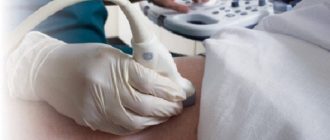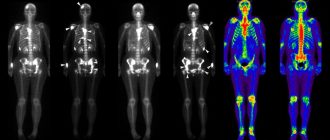Transabdominal ultrasound of the prostate gland is a low-information diagnostic procedure, which can still be useful in some cases. It is inferior in accuracy to the transrectal method, however, it allows for a better assessment of the complex of the male genitourinary system and the residual amount of urine. The procedure requires minimal preparation and can be performed in almost all cases, unlike TRUS, which has more contraindications and aversion among patients.
The essence of the method
Transabdominal ultrasound of the prostate is performed by scanning through the abdominal cavity. This is a painless and safe method.
Ultrasound of the prostate gland with an abdominal probe is prescribed for the following symptoms:
- erectile dysfunction;
- premature ejaculation;
- frequent urination;
- pain when urinating;
- urinary incontinence;
- difficulty urinating;
- male infertility;
- discharge from the seminal canal;
- nagging pain in the lower abdomen and perineum.
Scanning allows you to:
- determine the presence of inflammation or scarring of the prostate;
- check for suspected BPH and cancer;
- study the presence of cysts or stones in the genitourinary system;
- examine other organs of the pelvic and genitourinary systems (testicles, bladder, kidneys).
Ultrasound of the prostate gland should be done every six months (after 30 years), because diseases in the first stages may not cause any symptoms. However, during this period they are easiest to treat. The appearance of symptoms usually indicates their development, and therapy requires more serious measures and a longer period of time.
Differences from TRUS
The transabdominal prostate ultrasound method has some differences from the transrectal procedure:
- The picture of internal organs is less accurate because ultrasound passes through more tissue.
- It has fewer contraindications and allows for research in cases where the transrectal method is unacceptable.
- Requires less preparation and is more comfortable for the patient.
- Allows you to obtain data on the condition of the bladder and kidneys, which may also be necessary for making a diagnosis.
Preparation
Preparation for an abdominal ultrasound of the prostate is simpler and consists of:
- refusal to eat 8 hours before the examination;
- eliminating certain foods from the diet for 2-3 days;
- the need to drink 1.5 liters of water to fill the bladder.
Carrying out
A transabdominal ultrasound of the prostate is performed through the abdominal cavity with a full bladder. To perform the scan, you need to undress to the waist and lie on your back.
The test area is lubricated with gel, which ensures a tight fit of the sensor to the body and better penetration of ultrasonic waves.
During the scan, the doctor moves the sensor over the abdominal area and looks at the condition of the organs. An abdominal ultrasound of the prostate is done in conjunction with a bladder check, and if necessary, the doctor can check the kidneys.
To determine the residual amount of urine, the procedure is repeated after emptying the bladder.
Decoding the results
When conducting a transabdominal examination of the prostate gland, the doctor gives the patient a transcript and the data obtained. If necessary, an image is also provided so that the attending physician can visually assess the condition of the organ.



